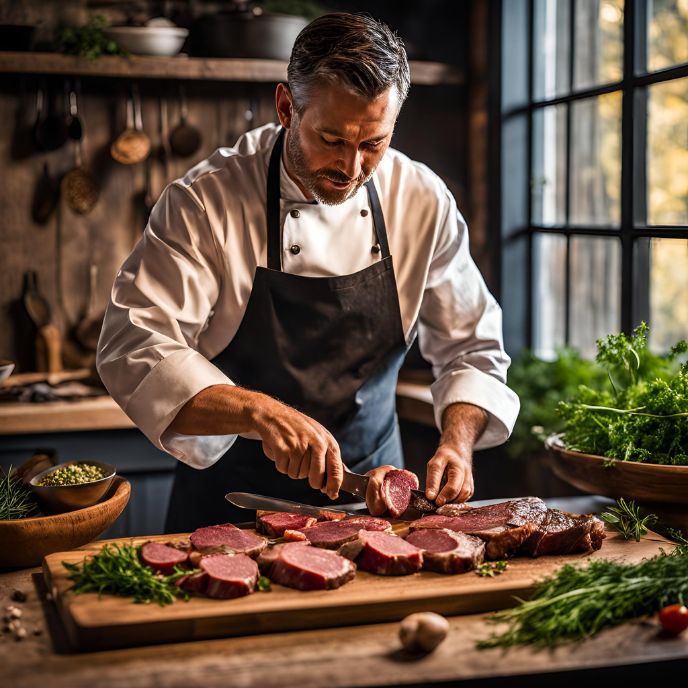Cooking elk medallions can be a delightful and flavorful experience, offering a lean and tender cut of meat that’s perfect for various cooking methods. Here’s an SEO-optimized, step-by-step guide to cooking elk medallions, incorporating practical tips and best practices, and designed to make the most of this rich, wild game meat.
Introduction
Elk medallions are cut from the tenderloin or backstrap, making them one of the most prized pieces of meat when cooking wild game. Known for their lean, slightly sweet flavor, elk medallions are versatile and can be prepared in several ways: pan-seared, grilled, broiled, or roasted. Whether you’re an experienced hunter or just learning how to cook elk, mastering this dish will impress your guests and elevate your culinary skills. Related keywords include “how to cook elk,” “elk tenderloin,” and “wild game recipes.”

Detailed Sections
1. Searing Elk Medallions
Pan-searing is one of the most popular methods to cook elk medallions. It creates a crispy crust while keeping the inside juicy and tender.
- Preparation: Season the medallions with salt, pepper, and optional spices such as coriander or garlic powder
- Cooking: Heat olive oil in a skillet over medium-high heat until it shimmers. Add the elk medallions and sear for 2-3 minutes on each side, forming a golden-brown crust
. Use a digital thermometer to ensure the meat reaches an internal temperature of about 130°F for medium-rare.
2. Grilling Elk Medallions
Grilling gives elk medallions a smoky flavor that complements the natural taste of the meat.
- Preparation: Preheat your grill to medium-high heat. Brush the medallions with olive oil and season them
- Cooking: Grill for 3-4 minutes on each side until grill marks appear and the meat reaches your preferred doneness.
3. Broiling Elk Medallions
Broiling is a great alternative if you don’t have access to a grill.
- Preparation: Preheat your broiler to high heat and place the elk medallions on a baking sheet
- Cooking: Broil for about 3-4 minutes per side until you achieve a good sear, checking the internal temperature to avoid overcooking.
4. Roasting Elk Medallions
Roasting elk medallions is an ideal method for cooking larger quantities.
- Preparation: Preheat your oven to 350°F and season the medallions.
- Cooking: Place the medallions on a baking sheet lined with parchment paper. Roast for about 15-20 minutes until the internal temperature reaches 130°F for medium-rare.
Tips & Best Practices
- Resting the Meat: Regardless of the cooking method, allow the elk medallions to rest for 5-10 minutes after cooking. This helps the juices redistribute, ensuring a tender and flavorful bite.
- Check Temperature: Always use a meat thermometer to prevent overcooking. Elk is lean, and overcooking can lead to tough, dry meat.
- Pairing with Sauces: Elk medallions pair beautifully with creamy sauces, like Crème fraîche mustard sauce or a red wine reduction.
FAQ Section
Q: What is the best way to season elk medallions?
A: A simple seasoning of salt, pepper, and spices like coriander or garlic powder enhances the natural flavor of elk medallions. You can also marinate the meat for 30 minutes for added flavor.
Q: How do I know when my elk medallions are cooked perfectly?
A: The best way to check is by using a meat thermometer. For medium-rare, aim for an internal temperature of 130°F.
Q: Can I cook elk medallions from frozen?
A: It’s best to thaw the medallions before cooking to ensure even cooking. However, if you must cook from frozen, extend the cooking time slightly.
Q: Can I substitute elk with another meat?
A: If elk is unavailable, venison, bison, or even lean beef tenderloin are great substitutes.
Q: How do I store leftover elk medallions?
A: Store leftover elk in an airtight container in the refrigerator for up to 3-4 days. It can also be frozen for up to 3-4 months.
Conclusion
Elk medallions are a delicacy that can be prepared in a variety of ways to suit your taste. Whether you prefer pan-searing, grilling, broiling, or roasting, the key is to cook them gently to preserve their tenderness. Remember to rest the meat, check the internal temperature, and experiment with different sauces for a flavorful and gourmet meal. With these tips and cooking methods, you’ll be able to create a memorable dish that showcases the rich, savory taste of elk.
For more wild game recipes and tips, check out other articles on wild game cooking and elaborate sauce pairings for a truly exceptional meal.

Related Articles :